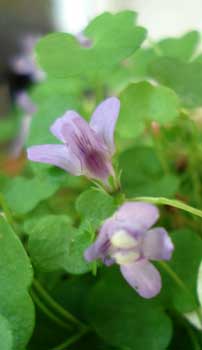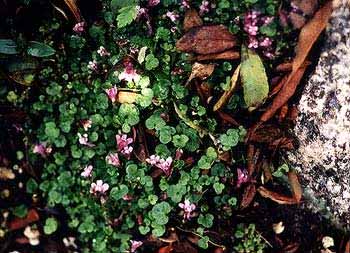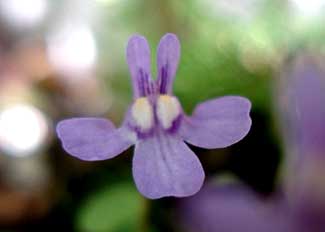
Toadflax;
or, Dwarf Kenilworth Ivy
"I think that, next to your sweet eyes,
And pleasant books, & starry skies,
I love the world of flowers;
Less for their beauty of a day,
And for a creed I've held away,
That they are sentient powers."
-Henry Timrod
(1828-1867)
 Cymbalaria aequitriloba (formerlyLinaria aequitriloba) is such a tiny groundcover even moss can appear tall beside it.
Cymbalaria aequitriloba (formerlyLinaria aequitriloba) is such a tiny groundcover even moss can appear tall beside it.Some discriptions say it gets one inch tall, but one discription said it grows "0 to 3 inches." Zero inches tall isn't all that absurd. Where we had it in the open garden, it was never even a full fourth-inch tall. It is rarely offered by nurseries because it might be mistaken for a bit of volunteer moss.
Granny Artemis planted a little start of this alongside the staircase to the lower street, where it is situated underneath Sword Ferns. It's a good thing it's close within hand's reach, as it frequently needed leaf litter brushed from it. It was simply too, too small, & after a couple years we got slipshod cleaning the leaf-litter off of it, & it was eventually smothered out.
 But we also have it much more lastingly in a pot which it shares with a dwarf Trillium. The trillium manages to show at least its leaves from early spring until July, but eventually the leaves vanish until the next spring, & so that the pot wouldn't look too empty we put the teency toadflax with it, & the toadflax blooms & reblooms spring & summer.
But we also have it much more lastingly in a pot which it shares with a dwarf Trillium. The trillium manages to show at least its leaves from early spring until July, but eventually the leaves vanish until the next spring, & so that the pot wouldn't look too empty we put the teency toadflax with it, & the toadflax blooms & reblooms spring & summer.In this well cared for pot it does get bigger than it did under the sword fern. It's all of an inch & a half high. I must've taken fifty pictures of the stuff trying to get a good one, & if you take enough, you eventually get something that works.
So while the second photo of the now-vanished bit of kenelworth under the swordfern is kind of a cruddy picture (though the best I managed to get in that location), the other three photos in extreme close-up are just so jolly. The flowers in reality, of course, are not much bigger than the head of a nail.
Dwarf Kenilworth Ivy has purple & white snapdragon-like flowers. It'll have an occasional surprise flower very early in spring or in late winter, but does not dust itself all over with blooms until May. It continues to have flowers on it from time to time right up to first frost in Autumn.
 The little toadflax is native of Spain & southern Europe. It is not an Ivy of course, but due to the three-lobed ivy-like shape of the teency leaves, it is generally marketed by the comelier name Dwarf Kenelworth Ivy, perhaps out of worry that customers for it would find Toadflax an off-putting name. The non-dwarf variety of Kenelworth Ivy is C. muralis & much more obviously a trailing vine.
The little toadflax is native of Spain & southern Europe. It is not an Ivy of course, but due to the three-lobed ivy-like shape of the teency leaves, it is generally marketed by the comelier name Dwarf Kenelworth Ivy, perhaps out of worry that customers for it would find Toadflax an off-putting name. The non-dwarf variety of Kenelworth Ivy is C. muralis & much more obviously a trailing vine.Dwarf Kenilworth attempts to be evergreen, but is not very cold-hardy. Though it does okay at about 15 to 20 degrees or a little cooler, a severe cold-snap could take it by surprise & do it in, though if any bit of its shallow root survives, it'll recover some little portion in spring, & rather slowly spread anew to fill its allotted space.
It is also sensitive to heat & has to be protected from much sun, making it a good match indeed for the dwarf trilliums, or for any potted plant that needs more shade than not, as the toadflax will bloom nicely even in bright shade.